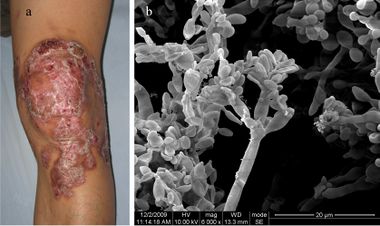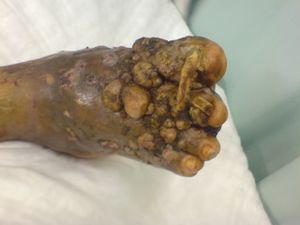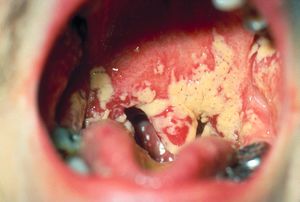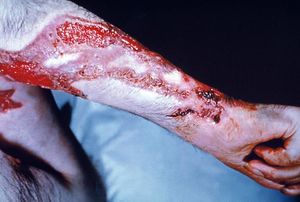Fungal Diseases
Original Editor - Lucinda hampton
Top Contributors - Lucinda hampton, Kim Jackson and Nupur Smit Shah
Introduction[edit | edit source]
Fungi are unicellular or multi-cellular eukaryotic organisms that exist in all environments worldwide. From fungi visible to the naked eye, such as mushrooms, to microscopic yeasts and molds, they exist in a multitude of forms.
Fungal diseases kill more than 1.5 million and affect over a billion people. However, they are still a neglected topic by public health authorities even though most deaths from fungal diseases are avoidable. Serious fungal infections occur as a consequence of other health problems including asthma, AIDS, cancer, organ transplantation and corticosteroid therapies[1][2].
- Although most fungi are harmless to humans, some of them are capable of causing diseases under specific conditions.
- Fungi reproduce by releasing spores that can be picked up by direct contact or even inhaled.
- Fungal infections are most likely to affect the skin, nails, or lungs. Fungi can also penetrate the skin, affect your organs, and cause a body-wide systemic infection[3].
Fungal diseases (also known as mycosis) differ from most bacterial diseases:
- They tend to be chronic and kill the host slowly
- Recalcitrant to therapy such that most invasive mycoses require treatment courses lasting months or longer.
- In contrast to bacterial and viral diseases, invasive human fungal infections are rarely communicable, and this has led to reduced interest by public health authorities in surveillance, so that we have relatively little information on the incidence and prevalence of mycoses[4].
- Morbidity rates linked to fungal infections represent an important health issue. For example, diseases such as chromoblastomycosis (see image 1) and eumycetoma (see image 2) lead to destructive deformations and debilitating conditions of the subcutaneous tissues, skin, and underlying bones, which result in social exclusion[5]
Image 1: A 34-year-old male with chromoblastomycosis, note a red plaque in the left knee. b. Under SEM observation: dematiaceous hyphae with many well-defined septa, conidiophores, and oval brown spores arranged in a clump could be seen.
Epidemiology[edit | edit source]
Individual fungal diseases have profound impacts on human health:
- Recent global estimates found the following occurring annually: 3,000,000 cases of chronic pulmonary aspergillosis; 223,100 cases of cryptococcal meningitis complicating HIV/AIDs; 700,000 cases of invasive candidiasis eg oral thrush, see image 3 R; 250,000 cases of invasive aspergillosis; 100,000 cases of disseminated histoplasmosis; over 10,000,000 cases of fungal asthma; 1,000,000 cases of fungal keratitis.[1]
- Around 220,000 new cases of cryptococcal meningitis occur worldwide each year, resulting in 181,000 deaths concentrated in sub-Saharan Africa.
- More than 400,000 people develop Pneumocystis pneumonia annually and die without access to therapy.
- In Latin America, histoplasmosis is one of the most common opportunistic infections among people living with HIV/AIDS, and approximately 30% of patients diagnosed with histoplasmosis in that region die from this disease[5].
Emerging Threat to Humans[edit | edit source]
The impact of fungi on human health has been underappreciated, despite the fact that these eukaryotic pathogens infect billions of people worldwide, killing in excess of 1.5 million per year.
Systemic fungal diseases:
- Rare in humans until the 1950s
- With the revolution of modern medicine ie antibiotics; development of intensive care units; start of the use of immunosuppressive agents (eg corticosteroids); the development of cancer chemotherapies; the inception of catheters (provide access for microbes on the body’s surface to the body’s interior) fungi able to exploit humans in new ways.
Fungal infections are determined by the fungal species and the immune status of the person infected. These invasive fungal diseases impose a major public health burden, with mortality rates of 30% to 90%, depending on the pathogen and patient population.[6]
- Superficial infections are the most common and include the 1 billion people with skin, hair, and nail infections. Mucosal infections with Candida (so-called “yeast infection”) are also very common eg over 135 million women afflicted repetitively
- More devastating are chronic, localized infections below the skin that are more common in tropical regions, as with mycetoma and chromoblastomycosis, which the World Health Organization (WHO) has recently classified as Neglected Tropical Diseases.
- Chronic fungal lung infections are complications of tuberculosis and other chronic pulmonary diseases, affecting millions globally.
- Fungal allergy common, with millions affected, worsening asthma and cystic fibrosis or leading to chronic nasal and sinus symptoms.
- Invasive fungal infections are progressive and lethal if not diagnosed and specifically treated.
- Most invasive fungal infections are caused by fungi with low pathogenic potential but cause disease in patients with defects in innate or acquired immunity eg premature births; HIV infection; severe influenza; immunosuppressive treatments.[6]
Fungal infections[edit | edit source]
Include (not limited to) the following: (Image 4 R: Patient’s arm shows the effects of the fungal disease sporotrichosis)
- Aspergillosis
- Blastomycosis. May be limited to the lungs or also involve the skin and bones. In its most severe form, can spread throughout the body and involve many organ systems).
- Candida albicans (usually localized infection, as of the vagina or mucous membranes of the mouth)
- Chromoblastomycosis (long-term fungal infection of the skin and subcutaneous tissue, occurs most commonly in tropical or subtropical climates, often in rural areas. It can be caused by many different types of fungi which become implanted under the skin, often by thorns or splinters)
- Coccidioidomycosis (a disease caused by inhaling spores of Coccidioides fungi, characterized by fever, respiratory infection, and reddish bumps on the skin, common in hot, semiarid regions, especially in southwestern U. S. and Mexico).
- Cryptococcosis (an infection caused by inhaling the fungus Cryptococcus neoformans. One of the diseases most often affecting AIDS patients. Cryptococcosis may be limited to the lungs, but frequently spreads throughout the body).
- Athletes foot (tinea pedis)
- Histoplasmosis (an infectious disease caused by inhaling the microscopic spores of the fungus Histoplasma capsulatum. The disease exists in three forms. Acute or primary histoplasmosis causes flulike symptoms. Most people who are infected recover without medical intervention. Chronic histoplasmosis affects the lungs and can be fatal).
- Mucormycosis (a rare but often fatal disease caused by certain fungi. It is sometimes called zygomycosis or phycomycosis. Mucormycosis is an opportunistic infection that typically develops in patients with weakened immune systems, diabetes, kidney failure, organ transplants, or chemotherapy for cancer).
- Onychomycosis, common nail infection (representing around 50% of all infections), common in the elderly. Increased risk of onychomycosis is associated with multiple factors, including male sex, old age, smoking, underlying medical diseases (eg, peripheral arterial disease, diabetes, and immunodeficiency), and predisposing genetic factors[7].
- Paracoccidioidomycosis (an often fatal, chronic granulomatous disease caused by Paracoccidioides brasiliensis ; it is endemic in Brazil and also occurs elsewhere in South and Central America and in arid regions of the southwestern United States. Infection primarily involves the lungs).
- Pneumocystis pneumonia
- Sporotrichosis, see image 4. (chronic infection The disease causes ulcers on the skin that are painless but do not heal, as well as nodules or knots in the lymph channels near the surface of the body. Infrequently, sporotrichosis affects the lungs, joints, or central nervous system and can cause serious illness).
- Tinea (Pityriasis) Versicolor See final image)
- Tinea cruris (A superficial fungus infection of the crotch and perineum known popularly as jock itch. Good general hygiene helps prevent it, as does keeping the area clean and dry).[8]
see also: fungal diseases in Zoonotic diseases
References[edit | edit source]
- ↑ 1.0 1.1 Bongomin F, Gago S, Oladele RO, Denning DW. Global and multi-national prevalence of fungal diseases—estimate precision. Journal of fungi. 2017 Dec;3(4):57.Available from;https://www.ncbi.nlm.nih.gov/pmc/articles/PMC5753159/(last accessed 6.11.2020)
- ↑ McKeny PT, Zito PM. Antifungal Antibiotics.2020 Available from:https://www.ncbi.nlm.nih.gov/books/NBK538168/ (last accessed 5.11.2020)
- ↑ Healthline Fungal Infections Available from:https://www.healthline.com/health/fungal-infection#types (last accessed 5.11.2020)
- ↑ Casadevall A. Fungal diseases in the 21st century: the near and far horizons. Pathogens & immunity. 2018;3(2):183.Available from:https://www.ncbi.nlm.nih.gov/pmc/articles/PMC6241320/ (last accessed 5.11.2020)
- ↑ 5.0 5.1 Rodrigues ML, Nosanchuk JD. Fungal diseases as neglected pathogens: A wake-up call to public health officials. PLoS neglected tropical diseases. 2020 Feb 20;14(2):e0007964 Available from:.https://journals.plos.org/plosntds/article?id=10.1371/journal.pntd.0007964 (last accessed 5.11.2020)
- ↑ 6.0 6.1 Fisher MC, Gurr SJ, Cuomo CA, Blehert DS, Jin H, Stukenbrock EH, Stajich JE, Kahmann R, Boone C, Denning DW, Gow NA. Threats posed by the Fungal Kingdom to humans, wildlife, and agriculture. mBio. 2020 Jun 30;11(3).Available from:https://mbio.asm.org/content/11/3/e00449-20#sec-2 (last accessed 5.11.2020)
- ↑ Gupta AK, Ricci MJ. Diagnosing onychomycosis. Dermatol Clin. 2006;24(3):365–9.
- ↑ The free dictionary Available from:https://medical-dictionary.thefreedictionary.com/sporotrichosis











